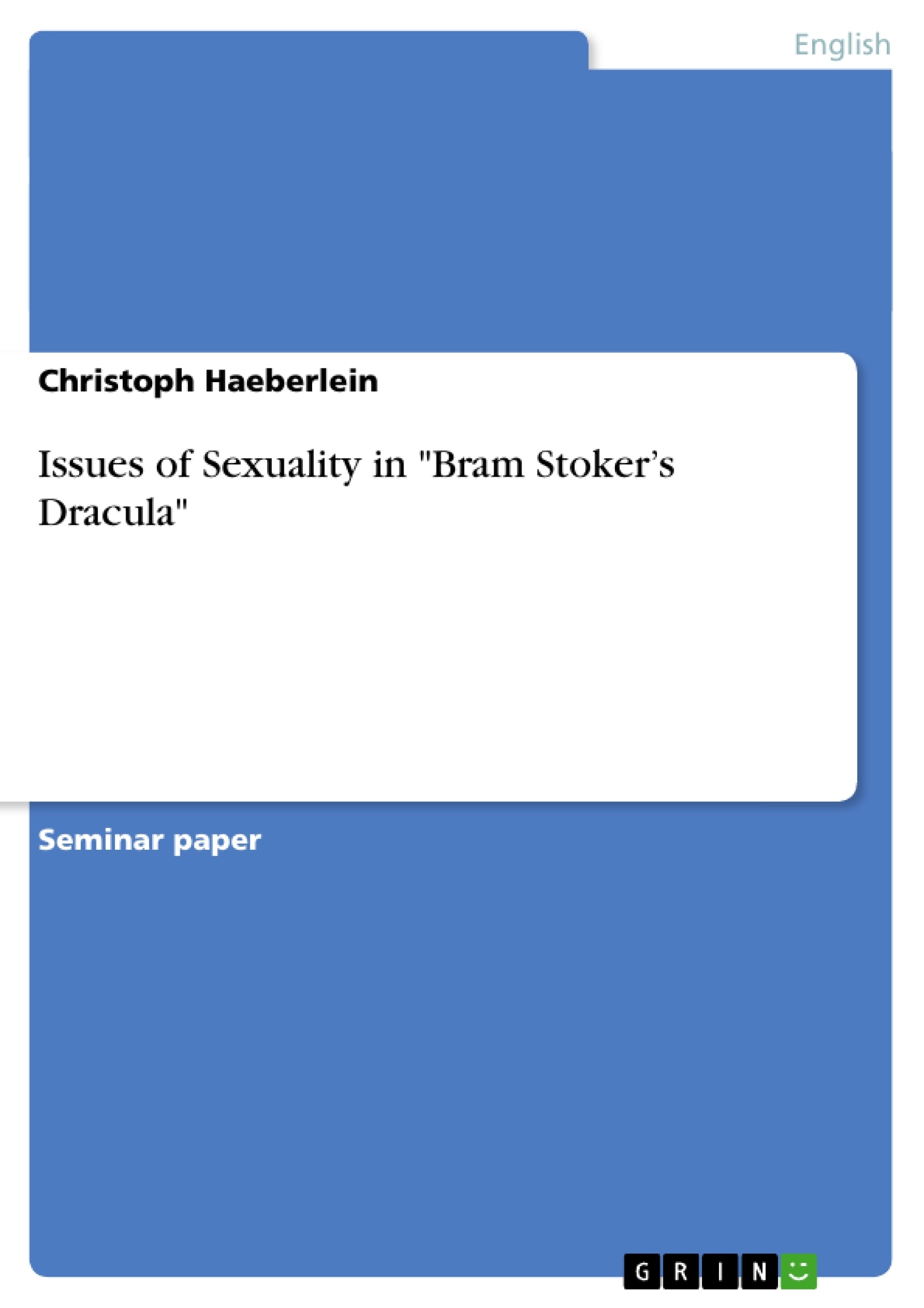Taking a look (an not even a close one) at movies or TV-series dealing with vampires, one immediately recognizes the vampire as a sexed-up figure, conveying the notion of the lascivious vamp as in Underworld, the noble alpha-male as in Blood Ties or the longed-for guardian and lover as in Moonlight. In her novels, Anne Rice describes the vampire’s bite as a liturgical act (cf. Brittnacher 1994:131), Sheridan Le Fanu’s female vampire Carmilla is actually a lesbian (cf. Leatherdale 1985, 54) and John Polidori’s early story The Vampyre is considered to have successfully combined the vampire-motif with a seducing romanticism (Hurst 2002, 139; Leatherdale 1985, 51). There is a long tradition in sexing up vampire-figures, reaching back even to Bram Stocker’s Dracula.
Indeed, Bram Stoker combined different aspects of the literary vampire when he created Count Dracula (cf. Brittnacher 1994, 119ff; Hurst 141f). This mixture of well-tried elements may be one of the reasons why Bram Stoker’s novel is widely seen as the “by far best-known literary treatment of the vampire myth” (Bentley 1972, 27). Amazingly, Dracula has never been out of print since it was first published in 1897 (Leatherdale 1985, 11; McNally et.al. 1994, 133) and can thus be said to have become the figurehead for the vampirism-phenomena. Consequently, James Twitchell asserts that “vampire and Dracula have become synonymous” (1981, 132).
Table of Contents
- Introduction
- Dracula as an (un-) conscious sexual allegory
- The Issue of the New Woman in Dracula
- Conclusion
Objectives and Key Themes
This paper investigates the sexual implications in Bram Stoker's Dracula, exploring whether Stoker consciously employed sexual allegory or if these elements were unintentional. It examines the novel's sexual symbolism within the context of Victorian society's strict moral codes and explores the potential connection between the novel and the "New Woman" ideal of the late 19th century.
- The presence and nature of sexual allegory in Dracula.
- The impact of Victorian societal norms on the representation of sexuality in the novel.
- The potential connection between Dracula and the "New Woman" ideal.
- Bram Stoker's awareness of the sexual themes within his work.
- Alternative interpretations of Dracula beyond its sexual themes.
Chapter Summaries
Introduction: This introductory chapter establishes the context for the analysis of sexuality in Bram Stoker's Dracula. It highlights the frequent association of vampires with repressed sexuality and romantic elements in literature, citing examples from Anne Rice, Sheridan Le Fanu, and John Polidori. The chapter emphasizes Dracula's unique position as the most well-known literary treatment of the vampire myth, its enduring popularity, and the ongoing debate regarding the extent and nature of its sexual content. The introduction poses the central question of whether Stoker consciously created a sexual allegory or if the sexual implications are unintentional.
Dracula as an (un-) conscious sexual allegory: This chapter delves into the pervasive sexual symbolism in Dracula, acknowledging the Victorian era's strong moral constraints on openly discussing sexuality. It questions whether Stoker was aware of the erotic undertones within his work, considering the societal pressures and potential risks of writing overtly sexual content. The chapter presents contrasting viewpoints, with some critics arguing Stoker was unaware of the novel's sexual energy while others highlight the detailed sexual symbolism as evidence of a deliberate choice. The discussion considers the implications of both possibilities, acknowledging the difficulty of overtly presenting such themes in the Victorian era.
Keywords
Bram Stoker, Dracula, Victorian literature, Gothic fiction, sexuality, sexual allegory, New Woman, repression, symbolism, Victorian morality, censorship.
Frequently Asked Questions: Analysis of Sexuality in Bram Stoker's *Dracula*
What is the main focus of this academic paper?
This paper analyzes the presence and nature of sexual allegory in Bram Stoker's Dracula. It explores whether the sexual themes are a conscious literary choice by Stoker or unintentional implications stemming from the Victorian context.
What are the key themes explored in the paper?
The paper investigates the sexual symbolism within Dracula, considering the constraints of Victorian societal norms. It examines the potential relationship between the novel and the "New Woman" ideal of the late 19th century, and considers whether Stoker was aware of, and intended, the sexual undercurrents in his work. The analysis also considers alternative interpretations of the novel beyond its sexual themes.
What are the main chapters covered in the paper?
The paper includes an introduction establishing the context of sexuality in vampire literature; a chapter dedicated to exploring Dracula as a possible (un)conscious sexual allegory; a chapter examining the "New Woman" theme in relation to the novel; and a conclusion.
What is the significance of the Victorian context in this analysis?
The Victorian era's strict moral codes and censorship regarding sexuality heavily influence the interpretation of Dracula. The paper explores how these societal pressures might have shaped Stoker's writing and the potential for coded or implied sexual themes.
How does the paper address the question of Stoker's intent regarding sexual themes?
The paper presents contrasting viewpoints on whether Stoker consciously employed sexual allegory. It considers evidence supporting both intentional and unintentional interpretations, acknowledging the complexities of overtly presenting such themes within the Victorian context.
What is the role of the "New Woman" concept in this analysis?
The paper examines the potential connection between the characters and themes in Dracula and the "New Woman" ideal of the late 19th century, exploring how the novel might reflect or challenge contemporary views on female sexuality and independence.
What are some key words associated with this analysis?
Key words include Bram Stoker, Dracula, Victorian literature, Gothic fiction, sexuality, sexual allegory, New Woman, repression, symbolism, Victorian morality, and censorship.
What other works are referenced in the introduction?
The introduction references works by Anne Rice, Sheridan Le Fanu, and John Polidori to contextualize the treatment of vampires and sexuality in literature leading up to Bram Stoker's Dracula.
- Quote paper
- Christoph Haeberlein (Author), 2006, Issues of Sexuality in "Bram Stoker’s Dracula", Munich, GRIN Verlag, https://www.grin.com/document/113255




